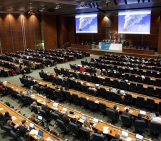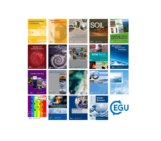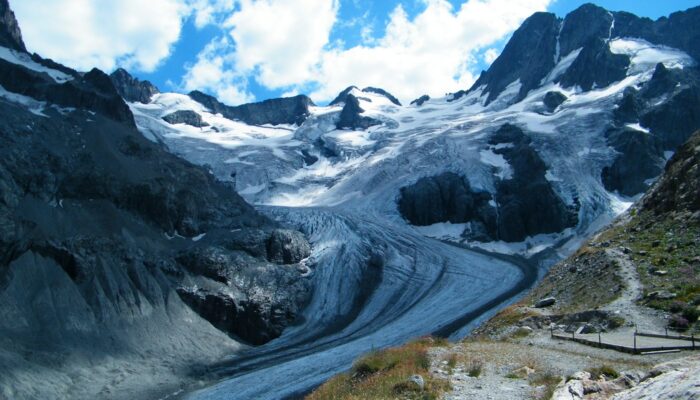
Drawing inspiration from popular stories on our social media channels, major geoscience headlines, as well as unique and quirky research, this monthly column aims to bring you the latest Earth and planetary science news from around the web.
Major stories
Latest IPCC report puts the oceans and cryosphere in focus
Last month the United Nations’ Intergovernmental Panel on Climate Change (IPCC) released a special report that details the current status of the oceans and icy regions of the planet, and assesses how these parts of the Earth will fare as the climate changes. The Special Report on the Ocean and Cryosphere in a Changing Climate (SROCC for short) also projects how future changes to Earth’s oceans and ice will impact the global population.
“The open sea, the Arctic, the Antarctic and the high mountains may seem far away to many people,” said Hoesung Lee, Chair of the IPCC. “But we depend on them and are influenced by them directly and indirectly in many ways – for weather and climate, for food and water, for energy, trade, transport, recreation and tourism, for health and wellbeing, for culture and identity.”
The 1,170-page report is packed with scientific details that illustrate how the environment is responding to climate change and what our world may likely look like under different carbon emission scenarios. We’ve listed just a few of the report’s findings here:
- “Small glaciers found in high mountain environments are projected to lose more than 80% of their current ice mass by 2100 under high emission scenarios.”
- “Even if global warming is limited to well below 2°C, around 25% of the near-surface (3-4 meter depth) permafrost will thaw by 2100.”
- “While sea level has risen globally by around 15 cm during the 20th century, it is currently rising more than twice as fast – 3.6 mm per year – and accelerating.”
- “Sea level rise will increase the frequency of extreme sea level events, which occur for example during high tides and intense storms. Some island nations are likely to become uninhabitable due to climate-related ocean and cryosphere change.”
- “Marine heatwaves have doubled in frequency since 1982 and are increasing in intensity.”
The key message of SROCC is that the world’s oceans are becoming warmer, more acidic and less productive, while melting glaciers and ice sheets are causing the sea level to rise. While we are already experiencing the consequences of these environmental changes, their future severity and impact on society is dependent on how much we reduce our greenhouse gas emissions, protect and restore ecosystems, manage our natural resource use, and plan for related risks.
Want to learn more about SROCC? You can check out Carbon Brief’s explainer piece that delves further into the details.
Hurricane-heavy September
The Atlantic hurricane season is usually the most active during the month of September, and this year several powerful cyclones have inflicted heavy damage on a number of coastal communities.
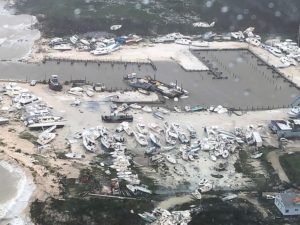
Hurricane Dorian destruction in Bahamas on September 2, 2019. (U.S. Coast Guard photo courtesy of Coast Guard Air Station Clearwater)
Last month, Hurricane Dorian broke records as the strongest cyclone of the season so far, and the second strongest Atlantic hurricane on record, with sustained winds reaching 300 km an hour. In its early stages, Dorian hit the Windward Islands and the US Virgin Islands, but it made the biggest impact on the Bahamas as a Category 5 hurricane. For more than 36 hours, the storm slowly dragged across the Great Abaco and Grand Bahama islands, unleashing severe wind, rain and storm surge. The American Red Cross reported that more than 13,000 houses (nearly half of the islands’ residences) were destroyed as a result. The official death toll across the country is 56, and at least 600 people are still reported missing as of 27 September.
Another notable September storm includes Tropical Storm Imelda. While Imelda’s winds were relatively slow (65 km an hour), the storm was the seventh-wettest storm on record in the United States, releasing more than a metre of rain onto southeast Texas. At least two people died from the event, and more than 1,000 high-water rescues and evacuations were made.
Hurricane Lorenzo is the latest storm to catch media attention. The storm reached Category 5 status in the central Atlantic on 28 September and was listed as the strongest hurricane on record this far north and east in the Atlantic basin. The US National Hurricane Center has reported that the storm, now a Category 1 hurricane, is passing through Portugal’s Azores Islands and is projected to make its way north to Ireland and the UK by the end of the week. While the storm’s intensity has weakened, the hurricane is still very dangerous. In the Azores Islands, Ireland and the UK, local authorities and residents have been preparing for severe weather conditions, including heavy rain and strong wind.
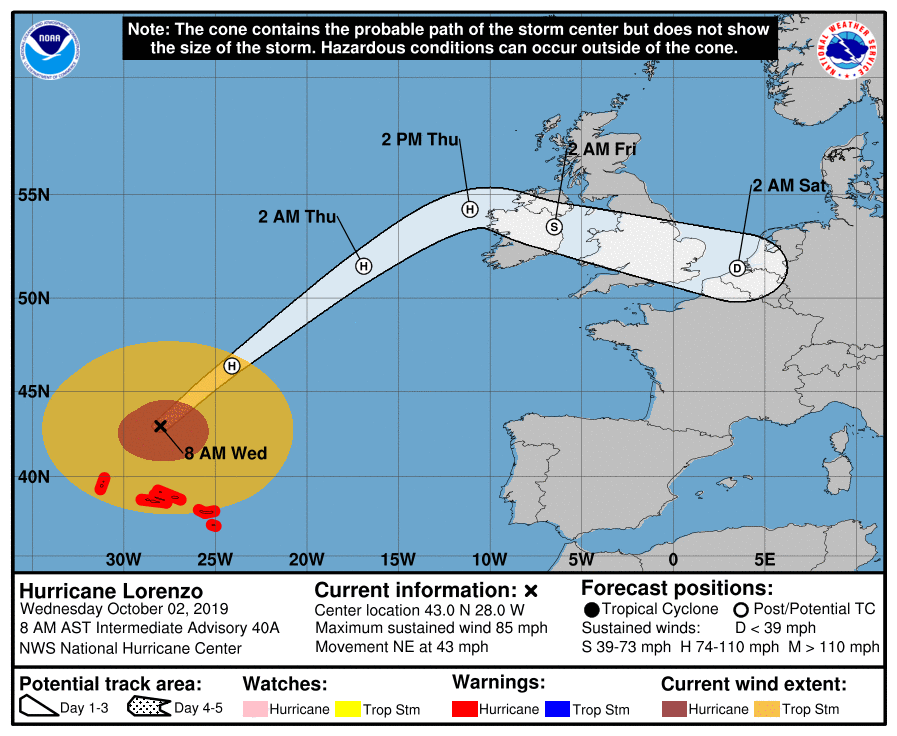
This graphic shows an approximate representation of coastal areas under a hurricane warning (red), hurricane watch (pink), tropical storm warning (blue) and tropical storm watch (yellow). The orange circle indicates the current position of the center of the tropical cyclone. The black line, when selected, and dots show the National Hurricane Center (NHC) forecast track of the center at the times indicated. (Credit: NOAA National Hurricane Center)
Many scientists estimate that, as the climate changes, hurricanes and storms will likely be slower, wetter and more intense.
What you might have missed
Is ‘The Blob’ back?
Last month news outlets have reported that a large expanse of the northeast Pacific Ocean has been experiencing unusually warm temperatures, in some places as much as 3°C higher than average records. Stretching from the Gulf of Alaska to the Hawaiian Islands, the marine heatwave is currently the second largest on record in this region in the last 40 years.
The US National Oceanic & Atmospheric Administration noted that the current heatwave resembles the early stages of ‘The Blob,’ a massive heatwave that first formed in 2014 and persisted for three years. This earlier heatwave was connected to several ecological disturbances, including large harmful algal blooms, whale entanglements, coral bleaching, sea lion malnourishment, and many fishery disasters. Scientists fear that if this new heatwave does not dissipate soon, the event could lead to similar consequences.
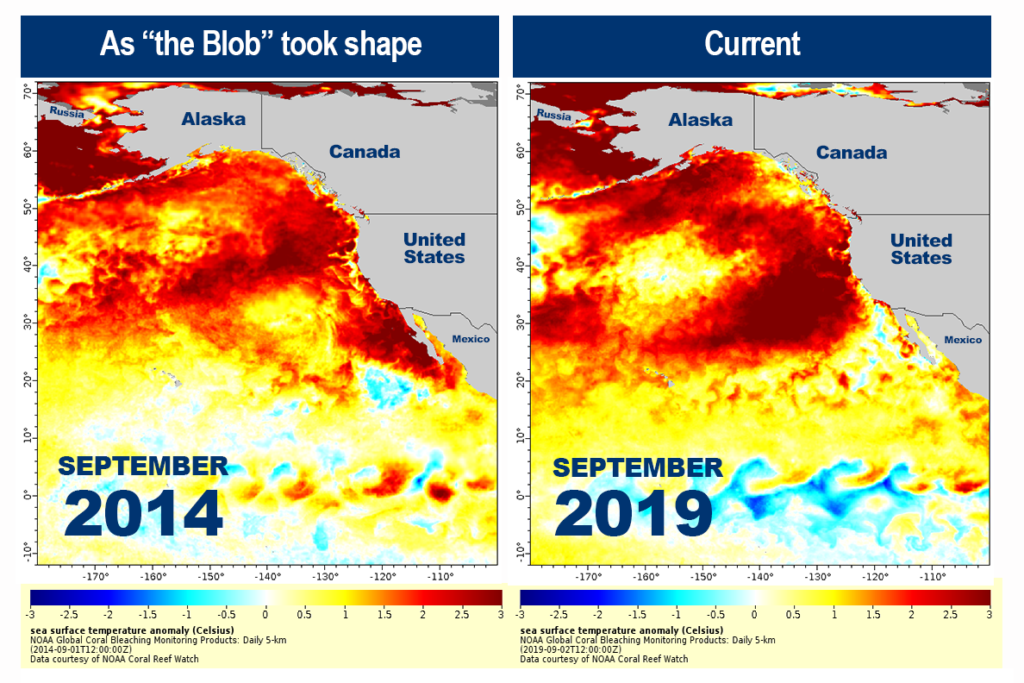
Sea surface temperature anomaly maps show temperatures above normal in orange and red. (Credit: NOAA)
An icy expedition
Also last month, an international team of polar scientists have launched the largest Arctic research expedition in history. On 20 September, the German research vessel Polarstern set off on a journey to the Arctic, where it will spend an entire year trapped in sea ice, allowing researchers to observe the region’s climate system. The project, known as MOSAiC (Multidisciplinary Drifting Observatory for the Study of Arctic Climate), will involve more than 300 scientists from 19 countries.
The vessel is expected to move with the natural ice drift towards the Atlantic as the year progresses, collecting valuable information on the Arctic atmosphere, sea ice, ocean, ecosystems and biogeochemistry. “We will go and do science wherever the ice might carry us,” said chief scientist Markus Rex, an atmospheric scientist at the Alfred Wegener Institute, to Nature News & Comment. Researchers hope that the data will give an updated comprehensive look into the current state of the Arctic, allowing climate models to make better estimations of the region’s future.
Other noteworthy stories
- Scientists worldwide join strikes for climate change
- A study of fossil meteorites suggests that a distant asteroid collision once sent Earth into an ice age
- Lost continent revealed in new reconstruction of geologic history
- K2-18b probably can’t host life as we know it, but it orbits in a cosmic sweet spot where water vapor in the atmosphere could turn into liquid
- Plastic pollution has entered the fossil record, research shows
The EGU story
This month, we have launched a short survey for EGU members to provide input on what they value from EGU, the results of which will help ensure that we remain responsive to what our members want. This is particularly important in a member-led organisation like the EGU. If you are an EGU member, we’d ask you to take 5-10 minutes to give feedback on EGU and its activities.
In General Assembly related news, we have opened applications for the third edition of our Artists in Residence programme. The programme is most attractive for scientist-artists, especially those already familiar with, and interested in, the EGU General Assembly. Applications are accepted until 1 December.
Finally, a note from the EGU Executive Secretary Philippe Courtial: “After 8 successful years at the EGU office, EGU Media and Communications Manager Bárbara Ferreira has decided to give a new orientation to her career. We would like to thank her for her tireless efforts and we wish her all the best for her future career.”
And don’t forget! To stay abreast of all the EGU’s events and activities, from highlighting papers published in our open access journals to providing news relating to EGU’s scientific divisions and meetings, including the General Assembly, subscribe to receive our monthly newsletter.

